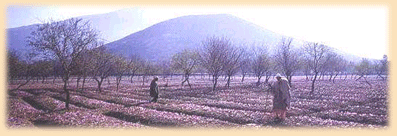SAFFRON CULTIVATION
Historical accounts of saffron cultivation in Kashmir dates back to 550 AD, i.e. nearly four Centuries earlier to its recorded cultivation in Spain (around 961 AD). Presently major producing countries are India, Spain & Iran.
In India, commercial saffron production is undertaken in J&K State only, where an area of over 20,000 hectare is reported under saffron cultivation with an annual production of about 20,000 kg of dried saffron. It is also being cultivated in some parts of Himachal Pradesh on experiment basis.
AGRO- CLIMATIC REQUIREMENT
- Climate
Pure Saffron cultivation can be successfully taken up in sub-temperate climate at an altitude ranging from 1500 m to 2400 m above MSL. Sunny days during flowering stage are favorable for good productivity. Saffron is a rained crop. In general, areas which receive 30 to 40cms of precipitation and remain covered with snow during winter are congenial for commercial Cultivation. Further, spring rains are favorable for corms production, a second spell of rains at the end of summer or at the beginning of Autumn is beneficial for profuse flowering.
- Soil
Pure Saffron cultivation can ideally be taken up in well drained loamy light soil having neutral to slightly Alkaline soil reaction. Water logging/poor drainage conditions of soil cause rotting of corms and Therefore, for successful saffron cultivation, the development of proper drainage system is an inevitable farm management requirement.
- Saffron Corms
Saffron is propagated through corms. The plant remains dormant from May to August. The mother corms reproduce annually 2-6 cormlets which are bulbous but slightly compressed, flowers during the following year. The mother corms provide food to the new developing corms and in doing so wither, shrink and finally die. Thus new corms keep developing each year to replace older ones.
- Land Preparation & Planting
The field is ploughed 4 to 5 times to a depth of 30 to 35 cm in the months of March-April to bring the soil into fine tilt. This is followed by a ploughing and leveling in the month of May.
It is recommended to incorporate 15 to 30 tones’ of Farm Yard Manure (FYM) during land Preparation. The planting of corms is then taken up in furrows of 8 to 10 cm deep following espacement of 8-10 cm corms to corms and 15 -20 cm row to row. The field is then laid out into 2.5 M square beds with a specific provision of 30 cm wide and 15 cm deep drainage channels around each bed.
- Seed Selection
The quality of seed material (corms) has marked influence on flower production. Therefore, the Corms selected for planting should be healthy and free from fungal diseases having a diameter of 3 Cm or more. In general, smaller size\ corms tend to produce only vegetative growth.
- Inter–cultural Operation
The fields planted with saffron seed are not disturbed till the following June in which month the First hoeing with short handled tongroo is done. This hoeing operation Provides aeration to the soil and is very important for proper development of corms. Second Hoeing is done in the first week of September, a month earlier to flowering of saffron. Soil is also Raised from the channels to the beds \ strips which are properly levelled .
During the time of second hoeing, light dressing of FYM @2 tonnes per hectare is recommended For the subsequent years to promote good growth of flowering shoots. After the ftowering season, Third and final light hoeings are given and manure is mixed with the help of iron rakes. This Schedule is followed every year.
- Fertilization
It is recommended to use Nitorgen (N), Phosphorus (P2 O5) and Potash (K2O) as Fertilizers in two doses during 2nd & 3rd hoeing.
- HARVEST
It’s the saffron season in Kashmir. Its late October. It is that time of the year again, when the Pampore plateau, a few Kilometers’ southeast of Srinagar, presents a breathtaking sight. The fields are full of small purple-colored flowers that produce the most expensive & exotic Spice in the world, saffron better known as Kesar in India.
There is joy in the air, as hundreds of men, women and children pluck the Flowers and put them in their wicker baskets. They are mostly cultivators and their families.
They have to work fast the flowers have to be picked hours after they reach Full bloom. Once they wilt, they are useless.
Plucking the flowers requires extreme care, but picking what is inside them requires more dexterity. Every flower must be held in one hand. The other turns back The purple petal and lift from each flower the red stigmas. Every flowers has three red stigmas (the female part), two stamens (the male part), And a long white stem connecting all of these to the main flower.
The stigmas are carefully dried in the sun to remove excess water. Impurities are removed by winnowing and passing it through sieves. It is then Graded for different qualities and packed in moisture-proof containers.
The kind of hard work that is required can be gauged from the fact that it is only after stripping about 150,000 flowers that a kilogram of saffron is obtained.
The moonlit nights of November in this region have melted many a hearts in this valley of flowers.











